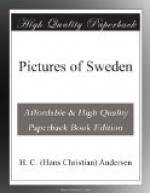Upsala student, thou art dear to us by thy disposition! thou art dear to us from thy lively jests! We will mention a trait thereof. In Upsala, it had become the fashion to be Hegelianers—that is to say, always to interweave Hegel’s philosophical terms in conversation. In order to put down this practice, a few clever fellows took upon themselves the task of hammering some of the most difficult technical words into the memory of a humorous and commonly drunken country innkeeper, at whose house many a Sexa was often held; and the man spoke Hegelianic in his mellow hours, and the effect was so absurd, that the employment of philosophical scraps in his speech was ridiculed, understood, and the nuisance abandoned.
Beautiful songs resound as we approach: we hear Swedish, Norwegian and Danish. The melody’s varied beacon makes known to us where Upsala’s students are assembled. The song proceeds from the assembly-room—from the tavern saloon, and like serenades in the silent evening, when a young friend departs, or a dear guest is honoured. Glorious melodies! ye enthral, so that we forget that the sun goes down, and the moon rises.
“Herre min Gud hvad
din Manen lyser
Se, hvilken Glands ut
ofver Land och Stad!”
is now sung, and we see:
“Hoegt opp i Slottet
hvarenda ruta
Blixtrar some vore den
en aedelsten."[O]
[Footnote O: Lord, my God, how Thy moon shines! See what lustre over land and city! High up in the palace every pane glistens as if it were a gem.]
Up thither then is our way! lead us, memory’s sprite, into the palace, the courteous governor of Upland’s dwelling; mild glances greet us; we see dear beings in a happy circle, and all the leading characters of Upsala. We again see him whose cunning quickened our perceptions as to the mysteries of vegetable life, so that even the toad-stool is unveiled to us as a building more artfully constructed than the labyrinths of the olden time. We see “The Flowers’” singer, he who led us to “The Island of Bliss;” we meet with him whose popular lays are borne on melodies into the world; his wife by his side. That quiet, gentle woman with those faithful eyes is the daughter of Frithiof’s bard; we see noble men and women, ladies of the high nobility, with sounding and significant family names with silver and lilies,—stars and swords.
Hark! listen to that lively song. Gunnar Wennerberg, Gluntarra’s poet and composer, sings his songs with Boronees,[P] and they acquire a dramatic life and reality.
[Footnote P: Gluntarra duets, by Gunnar Wennerberg.]
How spiritual and enjoyable! one becomes happy here, one feels proud of the age one lives in, happy in being distant from the horrible tragedies that history speaks of within these walls.




